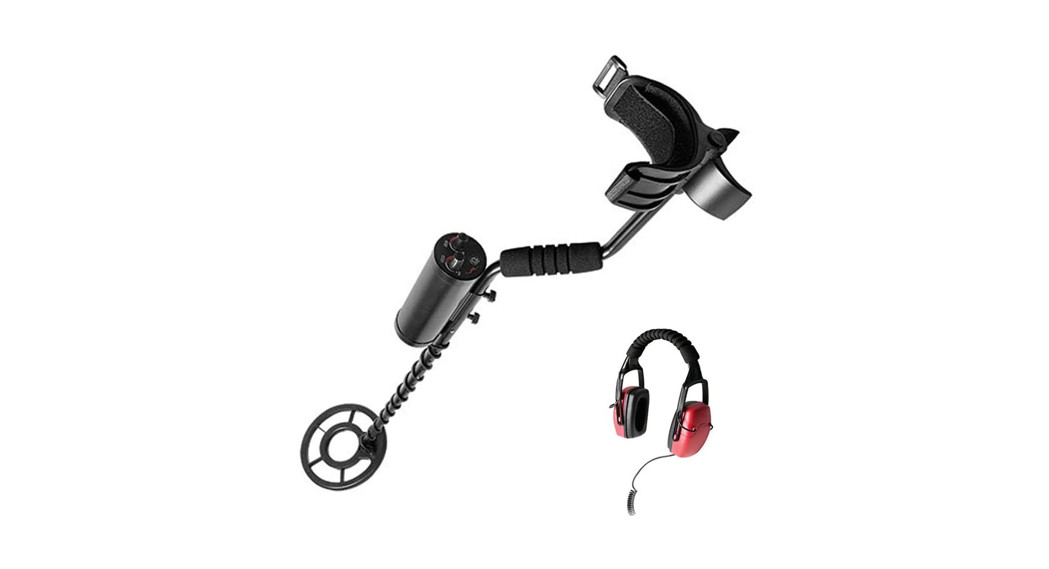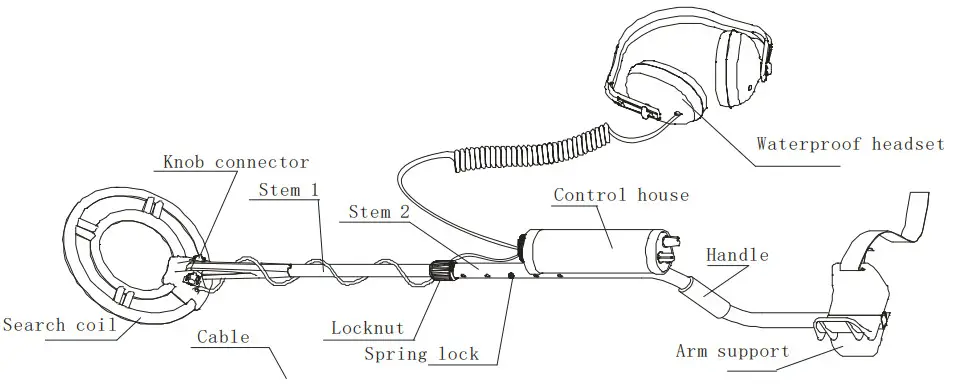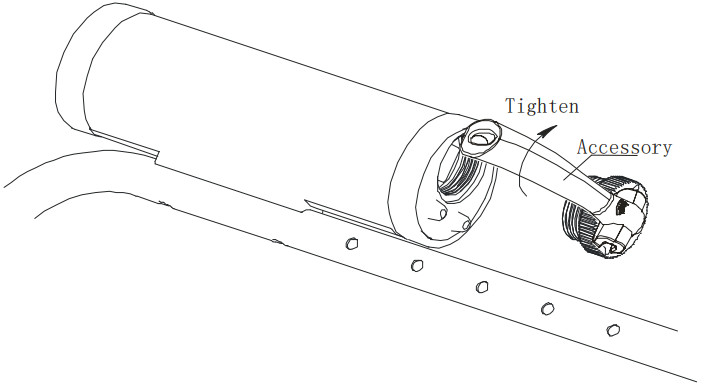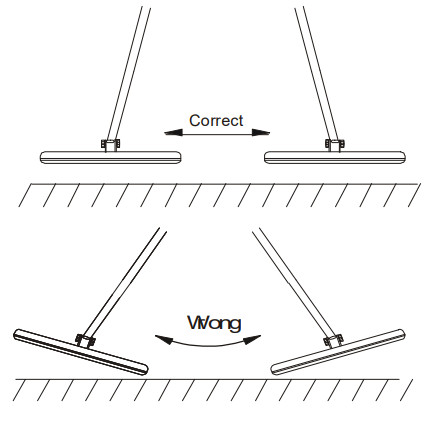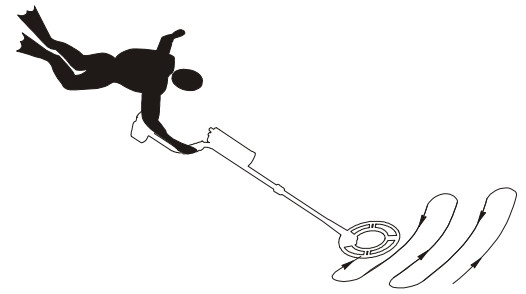Underwater Metal DetectorOwner’s Manual1MD6026
FEATURES
MD 6000 metal detector is a model with superb quality and performance. It not only has high sensitivity but also distinguishes the metal type. It can help the user to find lost coins, gold/silver jewelry, and metal objects, which can enable the users to have fun during operation.
- Motion detection has relatively low requirements on the environment.
- The Sensitivity adjustment function enables the detector to easily adapt to different environments.
- The Discrimination adjustment function enables the elimination of unwanted metal.
- A water-proof detector and headset enable underwater detection.
PREPARATION
1. Assembly
- Remove the stem and search coil assemblies from the shipping carton. Unscrew the knob on top of stem 1 and remove the knob connector. Insert the stem and align the holes on the search coil bracket and stem 1. Push the connector through the holes and tighten the knob.
- Then remove the control box fixed on the upper stem 2 with arm support from the shipping carton. Insert stem 1 into this upper stem 2 by snapping two spring locks on stem 1 into the proper holes on stem 2.
- Users may adjust the stem length at will. To extend the lower stem, push in the spring lock, pull out the lower stem and let the spring lock snap into another hole. Wind the search coil cable around the stem, make sure there is some slack, then tighten the locknut.

2. Battery installation
One 9 Volt 6F22 battery is used to power this detector.
- Set “SENS” on the position of“POWER OFF”

- Use an accessory to screw off the battery cover,place a 9V battery into the battery compartment by matching the polarity symbols (+ and -) marked on the connector.
- Reinstall the battery cover and tighten it with the accessory.
Caution:If you don’t plan to use the unit for a week or more, remove the batteries.Batteries can leak chemicals that can destroy electronic parts.
CONTROL PANEL
1. Illustration of the control panel.

- Power switch and “SENS” control:The sensitivity control is also the power switch. Rotate counter-clockwise to turn off the power. Rotate it clockwise, away from of, to turn on the power.
- “DISC” control:Rotate counterclockwise to detect all types of metal. Rotate clockwise to eliminate most of the junk metal. Different DISC degree is to be chosen according to different needs.
- LED & Headset:The LED flashes red when a target is detected, the closer to the target, the stronger the LED flashes. The LED will also flash red when the batteries need replacing.When LED flashes red, the headset will give out a sound of 400Hz TOO, which indicates that the detector is approaching the target or the battery needs replacing.
OPERATION
Clockwise rotate the “SENS” control to power on the detector.
1. “DISC” functionBy adjusting the Discrimination control you will be able to ignore small pieces of metallic trash while detecting valuable targets. Discrimination points are determined by such factors as size, shape, depth, and type of metal and ground mineralization.
- Scatter some sample targets such as coins pull tabs, and small pieces of foil on the ground 1 to 2 feet apart.
- Turn the Sensitivity Control clockwise to set the sensitivity to maximum.
- Turn the Discrimination control to counterclockwise.
- Put the headset on and turn on the POWER. Hold the search coil about 2 inches above and parallel to the ground. Move it slowly over the samples and note the LED and Audio response as you pass over each one. Keep in mind that MD6000 is a motion detector and responds only when the search coil is moving.
- Turn the Discrimination Control clockwise several points of the white region and again pass over the targets. Repeat this process at the yellow region and so on to the red region. You will note that as you change discrimination, MD6000 will reject some targets and continue to respond to others. You can determine the discrimination points per your needs. For example, the small nail discrimination may be at some point of the yellow region and the pull-tab discrimination point at the red region.
- Some objects such as shallow bottle caps, bent pull tabs or trash less than 2 inches from the coil may be difficult to reject. The headset will give out a broken signal that will usually disappear if the search coil is raised slightly. The strong signal of a good target will just get weaker too when the coil is raised.
- MD 6000 will remain silent when some objects are rejected, however other objects may “snap, crackle, and pop” as they are rejected. These is normal responses indicating that the powerful discrimination circuitry is doing its job.
- Large pieces of trash such as beer cans or jar lids may sound like good targets no matter what you do. With a little practice, however, you will be able to tell the difference between a large target and a small coin-sized object.
2 ”SENS” function
- Rotate clockwise to turn on the power, rotate to the full to set the highest SENS. High SENS should be used in most detections.
- Rotate counter-clockwise to decrease the SENS. Rotate counter-clockwise to turn off the power.
NOTES
The environment will directly affect the detection result. Through field detection, you will master how to properly conduct the operation. Some special circumstances are listed below to give some hints on how to detect and what to note when you detect in such an environment.
- If there are 2 detectors operating at the same time in your detection area while they’re also close to each other, it’ll lead to mutual disturbance. In this case, you may decrease the SENS or keep the 2 detectors far away from each other.
- If there is interference from an electrical cable or TV/Radio station in your searching area, lower the sensitivity or move away from the current searching area of disturbances.
- The proper SENS setting is very important when detecting in a complex environment. Sometimes a too high SENS will on the contrary lead to the non-ideal detecting result, because the soil mineralization and junk metals will both influence the signal which in turn affects the normal detection. Thus you need to repeat the SEN’s adjustment to reach the best condition. Only in a most ideal environment, can full SENS be set.
- The detection cannot be conducted if there is bulk metal near the object metal, since the signal from the bulk metal may exceed the one from the valued object metal. In this case, you have to remove this bulk metal or give up detection in this searching area.
TESTING(also applicable underwater)
- Turn on the power.
- Set “SENS” & “DISC” control on proper position.
- Find a place without metal objects.
- Place the object metal you want to search on the ground as the sample.
- Keep the search coil 1-2 inches from the ground, move the coil back and forth above the sample to observe the reaction.
Note:Please mark the place where to put the metal object in case of loss.
CORRECT USE OF THE SEARCH COIL
- Do not sway the search coil like a pendulum, or the lifted side of the search coil will cause false readings.

- Sweep your search coil in the following picture, move the search coil right and left in an arc line. For not missing any target, it is better to keep the distance from the search coil to the ground about 1 – 2 inches (closer to the earth for a smaller target) and the distance between two neighboring arcs is about 15 – 20cm. Please move slowly and it should be parallel between the arc lines in case the object can be missing.

CARE AND MAINTENANCE
Your MD 6000 metal detector is an example of superior design and craftsmanship. The following suggestions will help you care for your metal detector so you can enjoy it for years.
 |
Handle the detector gently and carefully. Dropping it can damage circuit boards and cases and can cause the detector to work improperly. |
 |
Use the detector only in normal temperature environments.Temperature extremes can shorten the life of electronic devices, damage the cases of the detector. |
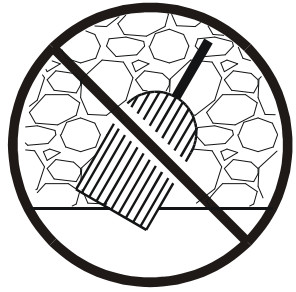 |
Keep the detector away from dust and dirt, which can cause premature wear of parts. |
 |
Wipe the detector with a damp cloth occasionally to keep it looking new. Do not use harsh chemicals, cleaning solvents, or strong detergents to clean the detector. |
WARNINGHandle the detector gently and carefully. Dropping it can damage circuit boards and cases and can cause the detector to work improperly.Keep the detector away from dust and dirt, which can cause premature wear of parts.
[xyz-ips snippet=”download-snippet”]

